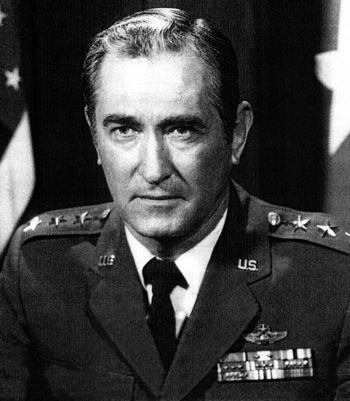
|
Royal N. Baker |
 |
|||
| Rank, Service | ||||
Lieutenant General O-9, U.S. Air Force |
||||
| Veteran of: | ||||
|
||||
| Tribute: | ||||
Royal Baker was born on November 27, 1918, in Corsicana, Texas. He graduated with a Bachelor's Degree in Industrial Arts from North Texas State Teacher's College in May 1941, and entered the Aviation Cadet Program of the U.S. Army Air Corps on June 2, 1941. Baker was commissioned a 2d Lt and awarded his pilot wings at Brooks Field, Texas, on January 9, 1942, and then completed Observer School before joining the 308th Fighter Squadron of the 31st Fighter Group in New Orleans, Louisiana, in March 1942. Lt Baker deployed with the group to England in June 1942, and to North Africa in November 1942, flying British Spitfires. Capt Baker was credited with the destruction of 3 enemy aircraft in aerial combat plus 1 probable and 2 damaged before returning to the U.S. in November 1943. His next assignment was with the 493rd Fighter Squadron of the 48th Fighter Group at Tullahoma, Tennessee, deploying to England in January 1944. Maj Baker shared in 1 air victory while flying with the 48th FG, and returned to the U.S. in December 1944, serving as a flight instructor until leaving active duty on November 24, 1945. After serving in the reserves for 2 years, he was recalled to active duty on July 3, 1947, and served as the base commander at Stewart Field, New York, from July to December 1947, followed by service as commander of the 2nd Fighter Squadron of the 52nd Fighter Group at Mitchel AFB, New York, from December 1947 to October 1949. Col Baker next attended Air Command and Staff College at Maxwell AFB, Alabama, from October 1949 to October 1950, and then served as Director of Operations for the 52nd Fighter-Interceptor Group and the 4709th Air Defense Wing at McGuire AFB, New Jersey, from October 1950 to April 1952. He then deployed to Korea where he served as the commander of the 4th Fighter-Interceptor Group from June 1952 to March 1953. During this time he added another 13 air victories, 1 probable, and 1 damaged enemy aircraft to his record, for a two-war total of 16.5 destroyed in the air, 2 probables, and 3 damaged. His next assignment was as a liaison project officer with Air Defense Command at Edwards AFB, California, from March 1953 to May 1957, followed by service as director of testing for the Air Force Flight Test Center at Edwards AFB from May 1957 to August 1960. Col Baker attended National War College in Washington, D.C., from August 1960 to June 1961, and then served as commander of the 20th Tactical Fighter Wing at RAF Station Wethersfield, England, from July 1961 to June 1963. Gen Baker's next assignment was as deputy commander of 3rd Air Force at South Ruislip AS, England, from June 1963 to July 1964, and he then served on the Joint Staff at Headquarters U.S. Air Force in the Pentagon from July 1964 to August 1966. He next served as vice commander of 12th Air Force in Waco, Texas, from September 1966 to March 1968, followed by service as Assistant Chief of Staff for Plans with the Military Assistance Command in Saigon, Republic of Vietnam, from March to July 1968. Gen Baker then served as vice commander of 7th Air Force at Tan Son Nhut AB, South Vietnam, from July 1968 to July 1969. During this time he flew 132 combat missions in Southeast Asia. He was commander of 17th Air Force at Ramstein AB, West Germany, from July 1969 to February 1971, and then served as Chief of the Military Assistance Advisory Group in Bonn, West Germany, from February 1971 to December 1972. Gen Baker's final assignment was as vice commander of Air Defense Command at Ent AFB, Colorado, from January 1973 until his retirement from the Air Force on August 1, 1975. Royal Baker died on April 17, 1976, and was buried at the Pecan Grove Cemetery in McKinney, Texas. |
||||
|
||||

